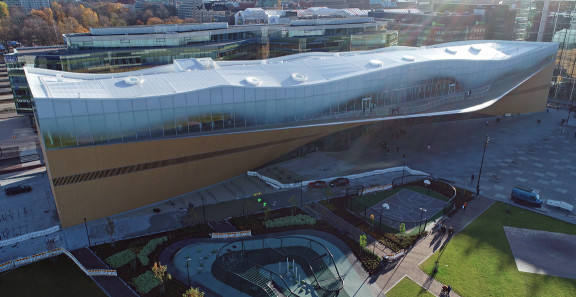The latest flagship project for Finnish construction – the Oodi Helsinki Central Library – is a new living room for Helsinkians and a tour de force in acoustic design. There was no shortage of challenges during the design and construction of the unique multipurpose building.
Stunning, unique, hotly anticipated, impressive, multipurpose – a living space for Helsinkians and a must-visit destination for architecture tourists from near or far. Helsinki’s Oodi central library, due to open towards the end of the year, is all of this and much more.
The principal and architectural design of Oodi was the responsibility of ALA Architects, the winners of the architectural competition, and YIT was responsible for construction contracting. However, hundreds of skilled professionals in various fields have been involved in design and construction, and the visually memorable and structurally challenging library will always be a special project for them.
Oodi is one of those buildings they will bore their grandchildren with: I was involved in designing/building that!
When something new is created, new things are applied and learned, no matter how experienced the professionals on the project may be, and this is what makes the work so fun and interesting.
Helimaki Acoustics, part of Sitowise Group, was responsible for the acoustic design of Oodi, and Pekka Taina, the acoustic designer and vibration expert who worked as Project Manager, says that everyone learns from each other on such a challenging site.
“Information is shared between designers in different disciplines, such as architectural, structural, building services and acoustic designers, and contractors. Although we will probably never come across a project quite like this again, these lessons can be put to use elsewhere.”
Oodi has been by far the most difficult site that acoustic designer Perttu Korhonen has faced in his career so far. “It’s no ordinary building. I’ve never come across anything like this before, and I probably won’t in the near future,” he laughs, thinking back.
Spaces of several types
For an acoustic designer, it is quite difficult to reconcile the expectation of peace and quiet in a library with the bustle of the surrounding urban fabric. Oodi was designed to complement the cultural and media hub of Helsinki Music Centre, Finlandia Hall, Sanoma House and the Kiasma Museum of Contemporary Art around Töölönlahti Bay. The superb location also means that it is impossible to avoid traffic noise.
Oodi is also more than just a traditional library for books. Each of the three floors has a separate function and each has its own soundscape. On the fast-paced, adaptable ground floor, there is an open lobby providing space for various events, along with halls, the library information desk, book return and a café.
The second floor houses various studio and game areas, working and meeting rooms, a city workshop, and other workshop and interaction spaces.
The third floor is dedicated to books and relaxation. There are also reading areas and a café.
In line with modern trends, the same building contains quiet areas required for concentration – a typical feature of libraries – but also studios and a cinema, where there is plenty of noise.
It was a major challenge to reconcile these functions, Perttu Korhonen notes.
Nowadays, it is quite normal for construction projects to call for very different functions to be placed in the same building. “Shopping centres incorporate cinemas, adventure parks, libraries, chapels and blocks of flats,” Pekka Taina says.
“The acoustic requirements of different areas must be addressed and reconciled to the extent possible.”
A further factor to keep in mind is the addition of flexible spaces, which acoustic designers often need to take into consideration in the design phase.
Oodi’s vaunted design language did nothing to make this easier, as the structural challenges added their own complexity to the project.
The acoustic designers addressed the problems one area at a time. The noisy areas were built using the room-in-room method. Noise and vibration insulation was implemented as well as possible in every area.
As regards building services, the problems were also solved one area at a time. In areas designated as quiet spaces, such as the library hall that stretches the entire length of the building on the third floor, the ventilation solution also needed to be quiet. “We also put a lot of effort into room damping,” says Perttu Korhonen.
Particularly in the cinema and studio areas, the target for the total noise generated by the HVAC equipment was very strict: a maximum of 25 dB(A).
Challenging structures
The unusual structural solutions employed in Oodi caused headaches for the designers of the noise insulation solutions for the areas within the building, as well as the noise insulation for the exterior walls.
“In principle, the building is a steel-framed bridge with flexible structures. There are several centimetres of leeway. This makes for an interesting challenge to implement noise insulation at the top ends of the partition walls,” Pekka Taina notes.
Oodi’s exterior wall structure, consisting of wooden elements hung from a steel structure, introduced problems of its own as the noise insulation is more challenging to implement than on a conventional concrete element façade.
“Noise is transmitted along the exterior wall, so this needed special attention. In particular, the ventilation machines placed against the exterior wall needed to be insulated with special care to provide noise insulation,” Perttu Korhonen says.
A Christmas present for Helsinkians
Oodi will open its doors in December, and visitors will be welcomed from the early morning to the late evening, seven days a week. Oodi is expected to welcome 2.5 million visitors every year.
Soon we will all be able to go and admire the handiwork of the talented architects involved. We will also be able to hear how well the acoustic designers have handled a challenge that seemed almost impossible!
Text: Dakota Lavento
